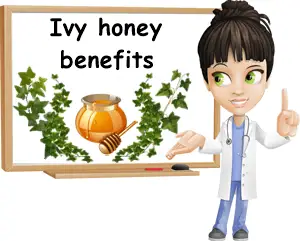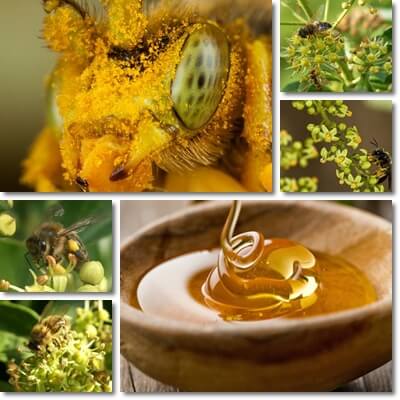Ivy honey is a monofloral variety made from the flower nectar and pollen of the common ivy or English ivy (Hedera helix). Ivy is an evergreen vine that climbs fences, houses, trees and even cliffs. Although an invasive species, the plant is largely used as an ornamental green facade for various buildings. The honey produced from its flowers is strong and somewhat unpleasant, but becomes good-tasting with time. Despite an initial disagreeable taste and smell, it boasts multiple therapeutic properties, notably cough-calming and antibacterial effects.
The honey is a natural contact-antimicrobial, effectively reducing the numbers of certain bacteria it comes into direct contact with and preventing the spread of the infection. Like many other honey varieties, it too is recognized for its effectiveness in managing and helping treat respiratory tract infections, especially coughs and flu. Moreover, it has a tonic, energizing action thanks to its vitamin, mineral and other nutrient content and mild prebiotic effects as a result of its generous content of natural sugars. Taken on an empty stomach, ivy honey is believed to help calm digestive discomfort and support gastritis healing.

The common ivy produces nectar-rich, small, yellow-green, umbrella-like flowers. The nectar is particularly appealing to honey bees because it’s sweet and found in generous amounts and because it’s available from the end of summer till the end of autumn, a time when other food sources for honey bees are scarce. It is not uncommon for ivy to have flowers during winter, if it’s particularly warm. If the honey is left in the bee combs during winter, it will most likely crystallize, becoming difficult to remove. Even when harvested in time, it crystallizes in as little as 2 weeks (it contains up to 80% glucose).
However, for us to enjoy its therapeutic benefits, ivy honey needs to be consumed raw, unheated and utterly unprocessed. Producers and some beekeepers are known to cream the honey to make it more convenient to use, but pay attention at the methods they use. Heating at higher temperatures especially can take away all of its beneficial properties. Also, if you are allergic to either ivy pollen or bee enzymes (needed to make the flower nectar into honey), then you need to avoid ivy honey and, in the second case, all bee products, including bee bread, propolis, royal jelly etc.
What does ivy honey look like? The freshly harvested and not yet crystallized honey has a medium dark amber color (a brownish yellow). As it granulates, it tends to lose its vivid pigment and takes on a paler color: a milky-yellow with beige-whitish undertones. The creamed varieties have a milky-yellow color and a softer texture than the naturally-crystallized honey which forms rougher crystals and is difficult to use as it is. Irish ivy honey is ivy honey produced in Ireland and has the same properties and health benefits as the ivy honey produced in other parts of the world.
What does ivy honey smell and taste like? Ivy honey is known to have a disagreeable taste and smell in the beginning, but the strong flavor and scent usually fade in a matter of months, leaving behind a pleasant-tasting and smelling honey. The freshly harvested honey has a slight ivy-like smell to it, faintly acidic, some say very similar to the scent of tree of heaven honey (ailanthus), also reputed for its bad scent. The taste is also unpleasant in the beginning, with a very strong herbal flavor, almost like an bad-tasting medicine, but with a moderate taste intensity and persistent aftertaste.

What are the health benefits of ivy honey? This particular variety is highly regarded for its therapeutic action. It has been suggested that the honey gets its medicinal effects from the ivy plant itself, known to possess expectorant, cough-relieving and antimicrobial properties. Here are 7 great uses and benefits of ivy honey:
1) Natural antiseptic and antibacterial. Ivy honey both prevents bacteria growth and actively reduces bacteria numbers, exercising a natural antimicrobial action. Such effects are a result of its content of hydrogen peroxide, a strong antibacterial, but also acidic pH which does not allow for bacteria growth and spread. Research is currently focusing on developing honey-based wound dressings that could significantly improve wound healing time.
Also, ivy honey generally contains 98% ivy pollen and pollen is known to have immunomodulating properties such as increasing white blood cell numbers for a better immune system response. This is a characteristic of ivy honey that further adds to its antibacterial action, although, for those allergic to the pollen, it is more reason to avoid it.
2) Good for respiratory tract infections. Eating raw, unheated and unprocessed ivy and other types of honey can help improve symptoms of upper respiratory tract infections in particular. The honey can be eaten as such or added to room-temperature tea (heat destroys its beneficial properties). It is important to let the honey exert its action, which is why it is recommended to avoid eating and drinking anything for at least an hour after taking it.
3) Calms cough and soothes sore throat. Ivy honey can help calm cough and soothe a sore throat. Its naturally thick texture, rich in natural sugars forms a sort of protective coating over the throat lining, protecting the sensitive mucous membrane from further irritation and stopping the spread of the infection by reducing bacteria numbers. The variety may also have expectorant properties, especially when it is taken in tea with lemon juice, but should be consumed raw for best benefits. The expectorant properties of ivy honey are believed to be passed down from the plant itself, which is known to be the source of some very efficient cough syrups and other cold and flu medicines.
https://www.youtube.com/watch?v=PRIkmZCJ-mw
4) Source of vitamins and other nutrients. Like all honeys, ivy too contains small amounts of several essential vitamins and minerals such as vitamin C, B vitamins, potassium, calcium, magnesium, phosphorus, zinc etc. It also contains other elements with nutritional value such as pollen particles or propolis, but also antioxidants.
5) Tonic action, fights fatigue, prevents hypoglycemia. The nutritional value and high sugar content of ivy honey make it a great natural tonic with energizing properties. The variety helps fight fatigue, low energy levels and prevents low blood sugar levels (hypoglycemia). However, diabetics should talk to their doctor about whether or not honey is a good food for them.
6) Prebiotic effects. The natural sugars in ivy honey are food for the good bacteria in our intestinal tract, having prebiotic effects. By supporting a healthy gut flora, the honey contributes to better transit time and digestive health.
7) Soothing on the stomach. Ivy, like other honeys, is soothing on the stomach, helping calm irritation of the stomach lining and possibly improving gastritis symptoms by encouraging healing. However, gastritis is a sensitive condition whose treatment relies heavily on a strict diet and any other remedy falls second to eating right.
Conclusion
Like many varieties, ivy honey too is often at the whim of seasonal and climate factors and can become pricey. Moreover, its rather unpleasant taste and extremely quick crystallization time add to the difficulty of enjoying it. Nevertheless, the raw honey remains a prized therapeutic food, with some very interesting medicinal uses, notably contributing to the management and treatment of respiratory infections and their symptoms, promoting digestive health and maintaining good energy levels.
